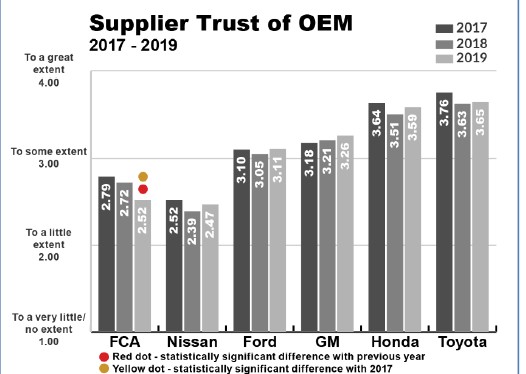SOUTHFIELD, MI – North American automakers must improve working relations with their supply base to meet emerging disruptions to their businesses, but an annual study shows limited progress in the harmony between OEM purchasing units and their parts and technology partners.
“It does appear that over the last five years, the differentiation among the OEMs is getting greater,” says Dave Andrea, principal-Strategy and Automotive/Mobility Consulting at Plante Moran and chief author of the annual North American Automotive OEM-Supplier Working Relations Study. “There has been a diversion from the higher-performing and the lower-performing (OEMs).”
Toyota and Honda again this year show the best relations with their suppliers. However, Honda moved ahead 15 index points this year to close on the heels of Toyota, which saw a more modest uptick of three index points.
Andrea says Honda capitalized on timely communication and handling sunk costs, or the investments a supplier may have made but due to a program or engineering change cannot be recovered.
“That will be important for Honda going forward,” he says of sunk cost. “They announced plans to reduce the number of trim levels and the complexity of their product. That is going to change production schedules and how a supplier may have been tooled up.”

That makes the cost of doing business with Honda, or Toyota, cheaper and as a result a supplier can offer more competitive pricing while maintaining or even improving their margins.
General Motors and Ford rank far lower in the study to form a middle-of-the-pack pairing. GM’s supplier relations soured just slightly, while Ford’s improved 12 index points. Nissan and Fiat Chrysler continue to occupy the lower rungs of the index, although the Japanese automaker gained 16 index points to overtake the Italian-American group. FCA US has seen its performance in the study decline since 2013.
The study, which drew 635 individual and consensus responses over more than 2,200 buying situations from 414 Tier One suppliers, is closely watched by the industry and investors because automakers with the soundest supplier relations receive the greatest benefits. Benefits from suppliers include a willingness to more readily share new innovations and technology, lower pricing and generally more favorable support, which manifest into higher OEM operating profits and competitive strength.
Andrea says the incremental progress made by automakers in supplier relations comes at a delicate time of industry transition.
“Purchasing organizations are being tested in this new environment of reductions in production schedules, the change in car and truck mixes and cancellations of (product) programs,” he tells Wards during a briefing on the report ahead of its release earlier today.
“The companies that are set up with the purchasing capabilities and capacities to deal with those kinds of transitions and stress will float to the top,” Andrea says. “Those that are more traditional, or set in a transactional purchasing methodology, will be tested.”
For index-trailing Nissan and FCA the stakes are particularly high, given the pace of change within the industry is occurring against a timeline for improving supplier relations that stretches several years.
“Do you have two or three years?” Andrea offers. “You have to have continuous improvement, program to program.”

Within the context of change, suppliers also are looking to maximize profit opportunities. For years, suppliers allocated their top talent and sizeable resources to a most-favored OEM. These days, they are targeting the most favorable product program.
“It gets fractionalized even that much more because the resources are so constrained,” Andrea says.
Communication and trust lie at the heart of supplier relations, especially in uncertain times with product programs in flux and millions of dollars and hundreds of jobs on the line at suppliers, the study shows. Those two components, which include elements such as protection of a supplier’s intellectual property and honestly fulfilling contractual agreements, directly correlate to benefits suppliers share with OEMs.
“If I show you a new idea, are you going to protect that?” Andrea asks. “If a red flag comes up, are you going to help if I come forward with it rather than trying to hide it?”
Toyota and Honda rank first and second in terms of communication and trust, followed by GM and Ford. FCA is trending down at fifth place, while Nissan is worst.
Another key element of the study shows which OEMs hold most-preferred-customer status. Toyota ranks first, followed by Honda, Ford, GM, FCA and Nissan decidedly last. Drilling down into six specific purchasing areas, such as chassis or the increasingly important electrical and electronics, Honda ranks best in four of the areas. Toyota takes the other top two spots and FCA ranks lowest in five of the six.
Andrea says restructuring within individual OEMs also can impact supplier relations. GM and Ford are slashing their workforces, which will put many new faces in front of suppliers.
Likewise, merger speculation at an automaker such as FCA draws uncertainty into a supplier’s business, while big corporate moves such as Toyota’s relocation of its headquarters to Texas from California and its purchasing group to Michigan from Kentucky creates employee turnover to affect relations. Toyota and Honda also are cycling through the first-generation workforce in the U.S., another factor affecting relations through turnover, Andrea adds.
“Whether it is setting up a new organizational structure, or internal communications, you have to adapt,” he says. “Because if you just stayed the same, (relations) would break down.”
At the end of the day, suppliers contribute 60%-70% to the value of a vehicle, Andrea says, so maintaining good relations is in an OEM’s best interest.





